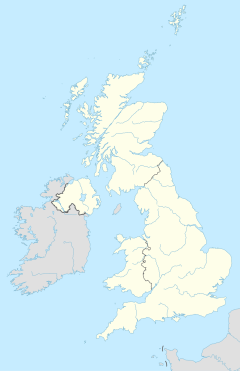Gonerby Hill Foot
| Gonerby Hill Foot | |
|---|---|
 Gonerby Hill Foot Primary School, Grantham | |
Location within the United Kingdom | |
| • London | 112 mi (180 km) S |
| Civil parish |
|
| District | |
| Shire county | |
| Region | |
| Post town | GRANTHAM |
| Postcode district | NG31 |
| Police | |
| Fire | |
| Ambulance | |
| UK Parliament | |
Gonerby Hill Foot (previously Gonerby Hillfoot) is an area of Grantham in South Kesteven in Lincolnshire, England. It is directly to the northwest of Grantham town centre, and near the border with Great Gonerby.
Gonerby Hill was said to be the steepest hill on the Great North Road from London to Edinburgh, until 1825 when the gradient was reduced by work done by Italian prisoners from Norman Cross Prison.[1] There is a mounting block dated 1703 at Gonerby Hill Foot, one of a series erected by Edmund Boulter along roads he regularly travelled.[1][2] The 1885 edition of Kelly's Directory of Lincolnshire states Gonerby Hillfoot is a hamlet in Great Gonerby parish, with the alternative name of Middle Gonerby (being between Little Gonerby and Great Gonerby), and lists a maltster, a brickmaker, and a shopkeeper in the hamlet, noting also that there is a wall letterbox.[3] An elementary school opened in 1908,[4] a forerunner of Gonerby Hill Foot Primary School.[5] On 1 October 1930, Gonerby Hill Foot became part of the enlarged borough of Grantham.[6][7]
The suburb is mostly residential; small "pockets" of older terraced housing remain, but from the 1970s onwards medium density semi-detached and detached housing has been built on developments laid out around cul-de-sacs.[8]
The grade II listed Gonerby House at Gonerby Hill Foot is Jacobean with Georgian and Victorian extensions.[9] It was used for student accommodation by The King's School for a period until 2002 and has since been divided into several residences.[10][1]
References
- ^ a b c "Gonerby Hill Foot". Grantham Civic Society. 20 November 2023. Retrieved 10 November 2024.
- ^ "Edmund Boulter's Mounting Blocks – September 2020 - the story so far" (PDF). The Milestone Society. Retrieved 12 January 2025. Includes a photograph of the stone, on page [2]
- ^ Kelly, E. R. (1885). "Great Gonerby". Kelly's Directory of Lincolnshire with the Port of Hull and neighbourhood... Kelly & Co. p. 416.
- ^ "Great Gonerby" (Transcript). Grantham Journal. 4 July 1908. p. 4. Retrieved 12 January 2025.
- ^ "Welcome to Gonerby Hill Foot". Gonerby Hill Foot Church of England Primary School. Retrieved 12 January 2025.
- ^ "Grantham AP/Tn/CP through time - Boundary changes". www.visionofbritain.org.uk. Archived from the original on 14 September 2024. Retrieved 12 January 2025.
- ^ "Absorbed parishes" (Transcript). Lincolnshire Echo. 30 September 1930. p. 7. Retrieved 12 January 2025.
- ^ "Grantham Townscape Assessment - CA06d: Gonerby Hill Foot residential suburbs". p. 8. Archived from the original on 3 October 2012.
- ^ Historic England. "Gonerby House (1360251)". National Heritage List for England. Retrieved 12 January 2025.
- ^ "Do you have memories of this Grantham house?". Grantham Matters. 30 January 2022. Retrieved 12 January 2025.
Further reading
- Crook, Ruth; Jefferies, Barbara (2008). The History of Gonerby Hill Foot and its School. Published by the authors. (available from Grantham Civic Society)

